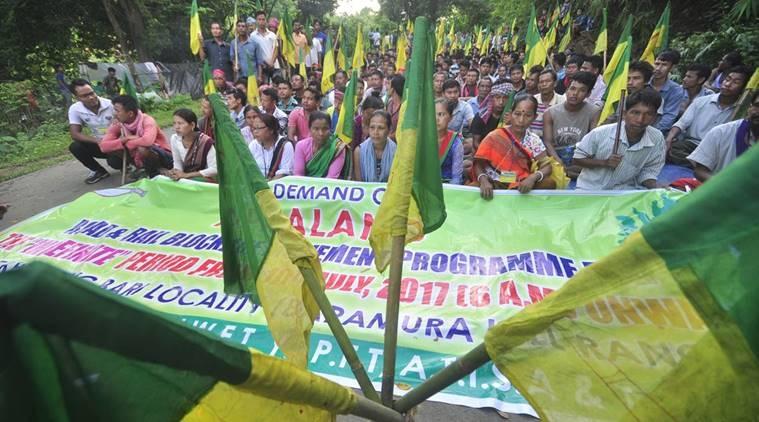The BJP in ‘Twipraland’

Image Courtesy: The Indian Express
On December 28, leaders of the Indigenous People’s Front of Twipura (IPFT) met with Himanta Biswa Sarma the Finance Minister for Assam to create an alliance for the forthcoming Assembly polls. They decided to meet again in Delhi on January 3 to discuss the matter further with BJP president Amit Shah. Earlier, in October, the CPI(M) had released a booklet outlining the development brought to Tripura by the Left Front govt. which has been in power continuously since 1993. The booklet also criticised the BJP for trying to rouse ethnic strife and separatism in the name of supporting tribal rights.
Tripura is a state that has often been used by ethnic nationalists in the Northeast as a case in point about unabated in-migration and the loss of identity. For over 500 years, the Kingdom of Tripura was ruled by the Manikya dynasty, who were ‘indigenous’ Tripuris. At its height it even included the Chittagong Hill Tracts (CHT) and Comilla. At present, the tribal population comprises 31% of the Tripura’s population. While the Left organised tribals and led their struggles against royalty and feudalism, the ‘separatist indigenous movement in Tripura began with the formation of the Tripura Upajati Juba Samiti (TUJS) in 1967. The TUJS later formed an armed wing called the Tripura National Volunteers (TNV). In the late 1980s, the National Liberation Front of Tripura (NLFT) and the All Tripura Tiger Force (ATTF) began their insurgencies. The various armed groups faced several ideological issues partly on the issue of religion, with Christians and Hindus unable to agree on much.
Under the patronage of the NLFT, the IPFT was formed in 2000. Their main campaign is for the establishment of Twipraland, a separate tribal state consisting of the hill districts of Tripura which make up around 60% of the state’s area. The roots of this conflict goes back to a time when the King of Tripura settled Bengali families in the plains areas near Agartala so that he could boost the revenue of his kingdom. This continued under the British. Settled agriculture yielded more revenue to the colonial masters and the King than jhum cultivation that was prevalent among the tribals. The few times the Tripuri Kings attempted to tax the hill people, they were met with revolts and uprisings, which had to be dealt with by the British. Upon signing the Merger Agreement in 1948, the onus of managing the rising tensions fell on the Indian Government.
The post-merger policies introduced by the various state governments since 1972 did strive to provide equal opportunities for development for both the hill people as well as those in the plains, the problems arose due to demographics. With around 70% of the population being Bengali speakers, Bengali became the lingua franca, even though it has the status of official language along with English and Kokborok. The various armed groups had embarked on ‘ethnic cleansing’ in Tripura, mostly in the areas adjoining the tribal heartlands. Their main demand being complete secession from India. The insurgency ripped apart Tripra’s fabric and took a heavy toll on lives, with over 3500 people killed. In 1997, the Armed Forces (Special Powers) Act, 1958 (AFSPA) was imposed in Tripura due to the raging insurgency. With effective policing strategies and a political campaign to isolate the insurgents from their support base, AFSPA was finally lifted by the Left Front govt. in 2015. Tripura became one of the rare instances where a flourishing separatist insurgency was isolated and defeated by astute political leadership and careful use of armed forces.
The BJP, which was nowhere on the scene during all this, is now seeking to find a footing by trying to align with both tribals and Bengalis, by pandering to chauvinist sentiments on both sides. The BJP strategy in the Northeast appears to be to favour groups that want statehood for their respective communities. The Gorkha Jan Mukti Morcha (GJMM) has supported BJP candidates to the Rajya Sabha based on the assumption that by doing so, the BJP will grant the demand for Gorkhaland. In Assam, the BJP entered into an alliance with the Bodoland People’s Front (BPF) to win the Legislative Assembly elections. The Kamtapur Progressive Party and the Kamtapur People’s Party also extended their support to the BJP in the hope of achieving a separate state of Kamatapur.
At present Gorkhaland is in a disarray, the people of the North Bengal Hills regret electing a representative from a party that can only make empty promises. The Bodos are not very happy either, as they too feel cheated. The Kamtapuris are another unhappy group who backed the BJP. There is no Gorkhaland, Bodoland, or Kamatapur. While the issues of language and culture are still an emotive issue, the BJP knows that to form the government in Tripura, it will have to win Bengali votes as well. To stay in power, if it does form the government, it will have to ignore the statehood demands of the IPFT. Yet both BJP and IPFT are circling around each other for several months trying to work out some common ground. In public, Himanta Biswa Sarma is telling them to drop the statehood demand. But yet discussions continue. Why?
The only conclusion that can be drawn is that the IPFT is fighting for relevance at a time when the people who they claim to be fighting for have seen insurgency, the end of the insurgency, and rehabilitation within the span of less than three decades. Similarly, the BJP is fighting for relevance in a state where it has had no base.
Get the latest reports & analysis with people's perspective on Protests, movements & deep analytical videos, discussions of the current affairs in your Telegram app. Subscribe to NewsClick's Telegram channel & get Real-Time updates on stories, as they get published on our website.























